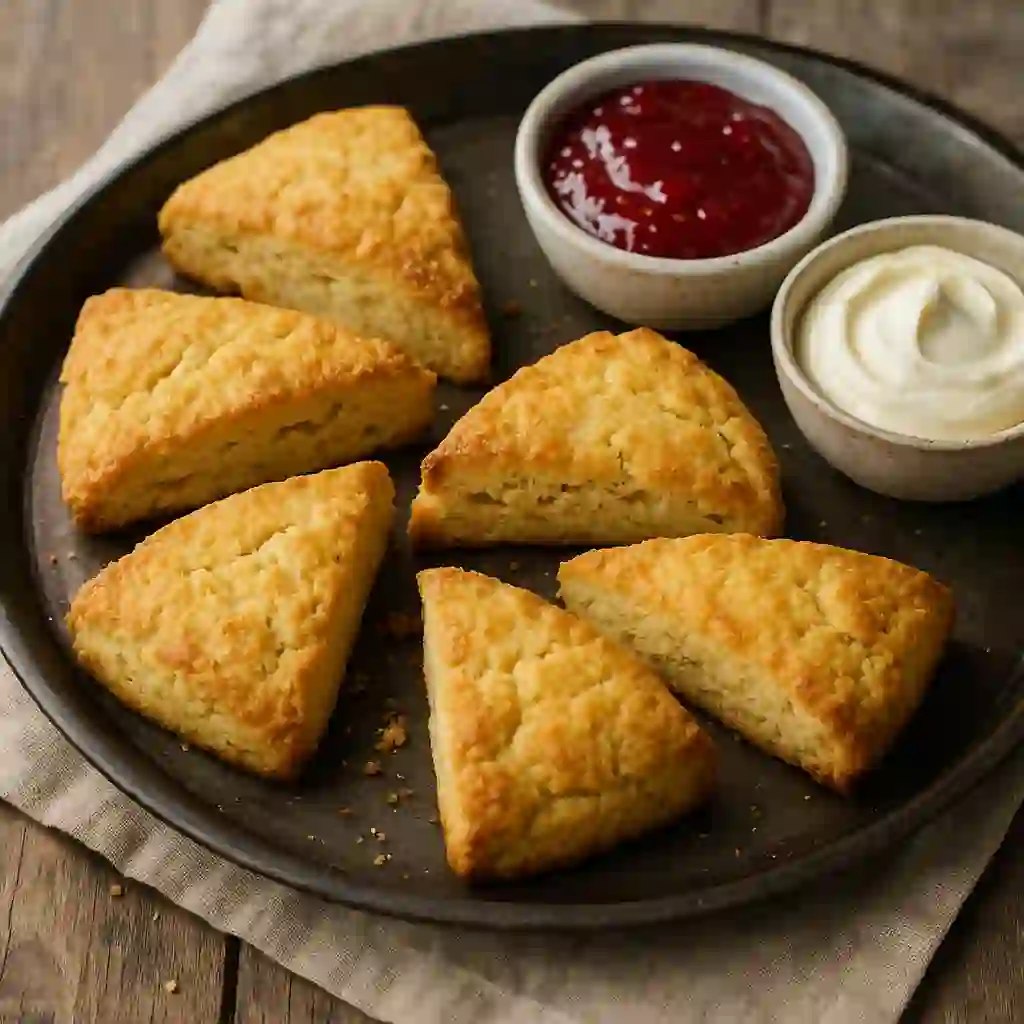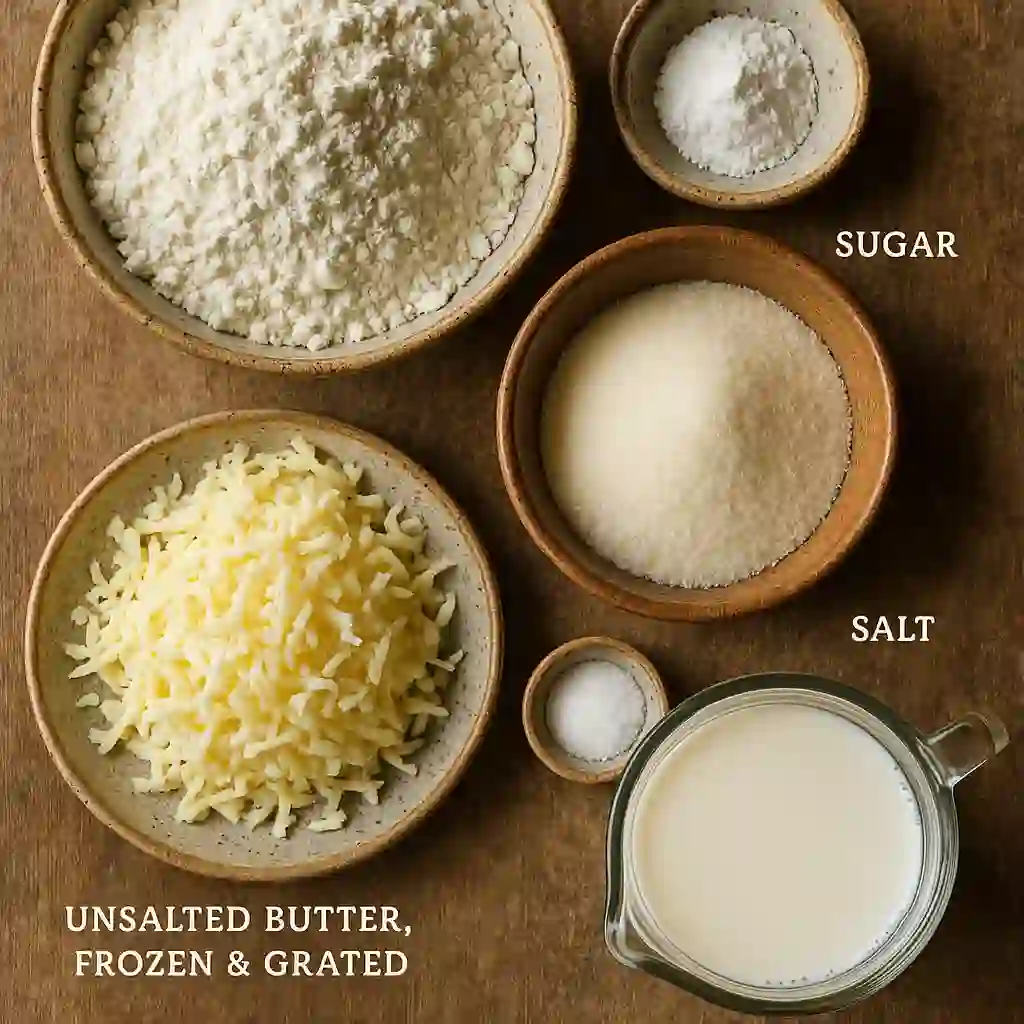Gluten‑Free Scones There’s nothing quite like the comfort of a warm, fluffy scone fresh out of the oven. But if you’re baking gluten-free, that dream can sometimes turn into a dense, crumbly disaster. Whether your scones come out flat, gummy, or dry, don’t worry. You’re not alone, and you’re definitely not out of luck.
Gluten‑Free Scones recipe
With a few smart swaps and insider tricks, you can make gluten-free scones that rise beautifully, taste amazing, and are 100% beginner-friendly. So, if you’ve been wondering whether gluten-free scones flour can deliver bakery quality scones yes, it absolutely can. Let’s get into the how.
Does Gluten-Free Flour Work for Scones?
Yes, gluten-free Scones flour can work wonders for scones but not all blends are created equal.
A good gluten-free scones all-purpose flour blend (like those from King Arthur, Cup4Cup, or Bob’s Red Mill) should be your starting point. These blends typically contain a mix of rice flour, starches (tapioca or potato), and binders like xanthan gum, which are essential for mimicking the structure of gluten.
If your flour blend doesn’t include a binder, you’ll want to add ½ to ¾ teaspoon of xanthan gum per cup of flour to help your dough hold together and rise.
Table of Contents
How to Bake Perfect Gluten‑Free Scones That Rise Every Time
Master gluten-free scones with these beginner tips! Learn how to get a perfect rise, choose the best flour, and troubleshoot common baking issues.
- Prep Time: 15 minutes
- Cook Time: 20 minutes
- Total Time: 35 minutes
- Yield: 8 scones 1x
- Category: Dessert
- Method: Baking
- Cuisine: American/British
- Diet: Gluten Free
Ingredients
- 2 cups (250 g) gluten-free all-purpose flour (with xanthan gum)
- 1 tbsp baking powder
- ¼ cup (50 g) sugar
- ½ tsp salt
- ½ cup (113 g) unsalted butter, frozen & grated
- ¾ cup cold milk (dairy or plant-based)
- Optional: 1 tsp vanilla extract, dried fruit, fresh berries, or shredded cheese
Instructions
- Preheat oven to 400°F and line a baking sheet.
- In a large bowl, whisk together flour, baking powder, sugar, and salt.
- Grate in cold butter, then mix with fingertips until it looks like coarse crumbs.
- Stir in milk (plus vanilla and add-ins if using) until dough just comes together.
- On a floured surface, gently pat dough into a 1-inch thick circle. Cut into 8 wedges.
- Chill wedges on tray for 10–15 minutes while oven finishes heating.
- Brush with milk or egg wash and bake 18–22 minutes, until golden.
- Cool on rack slightly before serving with jam or clotted cream.
Notes
Optimized Tips & Questions
- Hey Google, how do I get my gluten-free scones to rise?
Use fresh baking powder, cold butter, and chill the dough before baking. - Alexa, what’s the best flour for gluten-free scones?
Blends with rice flour, starches, and xanthan gum work best. - Siri, why are my gluten-free scones dense?
You may be overmixing the dough or using too much liquid.
Nutrition
- Serving Size: 1 scone
- Calories: 210 kcal
- Sugar: 6 g
- Sodium: 180 mg
- Fat: 11 g
- Saturated Fat: 7 g
- Unsaturated Fat: 3 g
- Trans Fat: 0 g
- Carbohydrates: 26 g
- Fiber: 2 g
- Protein: 3 g
- Cholesterol: 30 mg

The Trick to Baking with Gluten-Free Scones Flour
Here’s what separates flat, dry scones from the fluffy, tender ones:
1. Use Cold Butter—Very Cold
Grate frozen butter directly into your flour mix. Why? As the butter melts in the oven, it creates steam, lifting your scones and giving them flakiness. For extra insurance, chill your dough again before baking.
2. Don’t Skip the Binder
Xanthan gum or psyllium husk help build structure. They hold in moisture and trap air, giving your scones that desired rise.
3. Rest the Dough Before Baking
Give your shaped scones at least 10–15 minutes of chill time. This allows the flour to absorb moisture and firm up, preventing spread and promoting vertical lift.
4. Handle the Dough Gently
Overmixing warms the butter and develops a tough texture, even without gluten. Think of the dough like pie crust—treat it gently for the best texture.
What’s a Good Substitute for Flour in Scones?
If you’d like to build your own blend or avoid rice flour, try these:
- Almond Flour: Rich, moist, and adds lovely nuttiness. Best used in combo with starches.
- Oat Flour: Mild flavor and soft crumb. Use up to 25–30% of your mix.
- Sorghum or Buckwheat Flour: Great for hearty, earthy scones. Pair with tapioca or cornstarch for balance.
- Cassava Flour: A grain-free option with chew and stretch—just be careful not to overuse, as it can get gummy.
Always experiment in small batches when trying new blends to see how they affect rise and texture.
Why Aren’t My Gluten-Free Scones recipe Rising?
Let’s troubleshoot the usual suspects:
1. Your Baking Powder is Old
Expired leaveners won’t create lift. Replace every 6 months and use 1 full tablespoon for a nice rise.
2. The Dough is Too Wet or Too Dry
Gluten-free flours vary in absorbency. If your dough is too sticky, the scones will spread. If it’s too dry, they won’t rise.
3. The Oven Isn’t Hot Enough
Scones recipe need a blast of heat (375°F to 425°F) to puff. A lukewarm oven results in spreading, not rising. Always preheat thoroughly.
4. Your Dough Was Overworked
Handling scone dough too much breaks down structure and releases too much moisture. Less mixing = more rising.
5. You Didn’t Chill Before Baking
Chilling allows the fats to firm and flours to hydrate. It’s a secret weapon for structure and height.

Foolproof Gluten-Free Scones Recipe for Busy Beginners
Prep Time: 15 mins
Cook Time: 20 mins
Yield: 8 scones
Ingredients
- 2 cups (250 g) gluten-free all-purpose flour (with xanthan gum)
- 1 tbsp baking powder
- ¼ cup (50 g) sugar
- ½ tsp salt
- ½ cup (113 g) unsalted butter, frozen & grated
- ¾ cup cold milk (dairy or plant-based)
- Optional: 1 tsp vanilla extract, dried fruit, fresh berries, or shredded cheese
Instructions
Preheat oven to 400°F and line a baking sheet.
In a large bowl, whisk together flour, baking powder, sugar, and salt.
Grate in cold butter, then mix with fingertips until it looks like coarse crumbs.
Stir in milk (plus vanilla and add-ins if using) until dough just comes together.
On a floured surface, gently pat dough into a 1-inch thick circle. Cut into 8 wedges.
Chill wedges on tray for 10–15 minutes while oven finishes heating.
Brush with milk or egg wash and bake 18–22 minutes, until golden.
Cool on rack slightly before serving with jam or clotted cream.
Conclusion
Mastering the art of baking gluten-free scones recipe is absolutely achievable, even for beginners with busy schedules. By using cold butter, a high-quality gluten-free flour blend with xanthan gum, and following the right mixing and baking techniques, you can consistently bake light, fluffy, and flavorful gluten-free scones recipe that rise beautifully.
Avoid common pitfalls like overmixing and warm ingredients, and always chill your dough for best results. Whether enjoyed plain, with fruit, or savory add-ins, gluten-free scones recipe can become your go-to comfort bake. With practice, you’ll perfect your own signature batch of delicious, bakery-style gluten-free scones recipe at home.
Now grab that flour, set your timer, and get baking. Your perfect gluten-free scones recipe moment awaits.
Looking for more allergy-friendly recipes?
Don’t miss our gluten-free-cheese-and-marmite-scones
Check out plain Scones
Discover great ideas like pumpkin-scones-classic
Learn more about cheese-marmite-scones
FAQs
What type of flour is best for scones?
For traditional scones, all-purpose or cake flour works well due to its moderate protein content. For gluten-free scones recipe, the best results come from all-purpose gluten-free flour blends that contain xanthan gum or guar gum to mimic gluten’s structure. Popular options include King Arthur Measure for Measure and Bob’s Red Mill 1-to-1 Baking Flour.
Why are my gluten-free scones not rising?
Gluten-free scones recipe may not rise due to expired baking powder, warm or overmixed dough, excessive moisture, or skipping the chilling step. For a better rise, always preheat the oven, use fresh leavening agents, and chill the dough before baking to firm the butter and activate lift during baking.
Can you knead gluten-free flour?
You should avoid kneading gluten-free flour like traditional doughs. Since it lacks gluten, kneading won’t develop structure and can lead to dense or gummy textures. Instead, mix until just combined to keep the dough tender and allow for proper rise.
Can you use gluten-free flour in lemonade scones?
Yes, you can substitute gluten-free flour in lemonade scones. Use a high-quality gluten-free blend with a binder like xanthan gum. Because gluten-free flours absorb liquids differently, start with slightly less lemonade and cream, then adjust for a soft but not sticky dough.
What to avoid when making scones?
Avoid overmixing the dough, using warm butter, or overbaking. These can cause scones to become tough, flat, or dry. Also, resist adding too much flour when shaping, which can dry out the dough and reduce tenderness.
What is the secret of making good scones?
The secret lies in using very cold butter, handling the dough gently, chilling it before baking, and using fresh baking powder. Proper hydration, minimal mixing, and baking at the right temperature (375–425°F) all contribute to tall, tender, and flaky scones.
How do I make gluten-free scones recipe?
Start with a gluten-free flour blend that includes xanthan gum. Mix dry ingredients, then cut in cold butter until crumbly. Add cold milk or cream just until the dough comes together. Gently shape, chill the dough for 10–15 minutes, and bake at 400°F for 18–22 minutes. Avoid overmixing and ensure ingredients stay cold throughout.
Did you try Our Recipe?
There are no reviews yet. Be the first one to write one.


